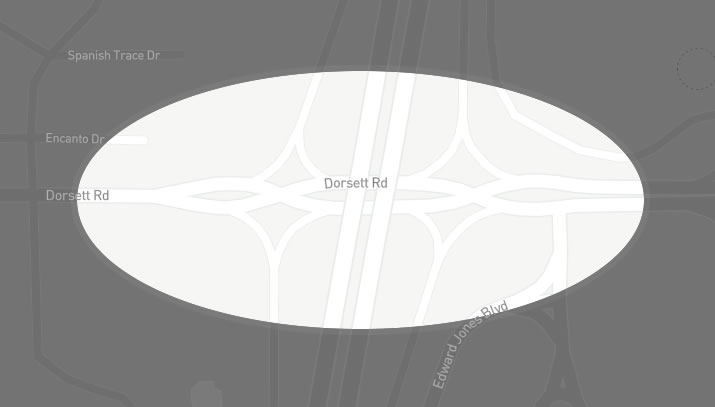Everyone has a preferred driving route, whether it’s to avoid congested streets or to take the scenic route.
But it may be time to rethink your driving path- a new study ranks Missouri’s most dangerous intersections.
The rankings come from a “collision danger index” (CDI) formula, invented by the researchers: Accidents (x1) + Injuries (x3) + Fatalities (x10) = CDI. The Missouri Department of Transportation (MoDOT) provided 2015’s collision records, the most recent complete year.
The most dangerous intersection, according to the study, is in Maryland Heights at Dorsett Road and I-270 with 149 accidents resulting in 48 injuries. It’s only one of two Maryland Heights intersections to make the list of 200 but even more surprisingly, it’s a diverging diamond intersection (DDI).

Maryland Heights at Dorsett Road and I-270
DDIs are believed to reduce many types of accidents by helping traffic flow, limiting driver confusion and reducing pedestrian crossing distance. A recent University of Missouri study supported these beliefs, as well, finding DDIs decreased injuries and fatalities by 63 percent and total accidents by 41 percent.
MoDOT’s district traffic engineer Derek Olson agrees DDIs enhance road safety and said there must be other factors contributing to the site’s high danger index in an interview with KSHB.
One of those factors could be traffic flow- something the study does not include. Certain intersections are continuously crowded while some may experience bursts of congestion if around stadiums, for example.
However, MoDOT does not keep track of traffic volume across the state, making this ideal scenario currently impossible. The study does note their results don’t inherently prove DDIs are more dangerous or unsuccessful, but rather drivers have yet to master the new road design.
The point of the study, however, was not to bring attention to DDIs but to shine light on problem areas.
“It’s up to the drivers using the roads to operate their vehicles safely, but the knowledge of where and when to exercise greater caution can absolutely help,” the Springfield personal injury attorneys (who commissioned the study) write. “The trends noted in this study can help identify major problem areas for local government officials to apply their attention. A proactive approach to the most problem intersections in a city could help save lives.”
And this is where the attorneys and MoDOT agree.
Olsen estimates about 90 percent of Missouri’s accidents are from human error; the law firm agrees, noting they have more distracted driving cases than anything else.
So whether the list makes drivers put down their phones at these intersections, drive at safer speeds or overall remain alert, hopefully Missouri can see a decline in overall crashes, injuries and fatalities from car accidents.
In 2015, the same year of the study’s data, Missouri experienced an increase in fatalities and injuries from accidents after a five-year decline.
Below is a list of the ten most dangerous in three major cities; to see all of the study’s findings and if any dangerous intersections are apart of your daily commute, click here.
Top 10 Most Dangerous St.Louis Intersections
- I-44 and Jefferson Ave
- I-70 and Salisbury St
- I-64 and Kingshighway
- I-70 and Grand
- I-64 and Hampton
- Bircher and Union
- I-55 and Park
- I-44 and Hampton
- I-70 and Adelaide
- I-70 and Shreve
Top 10 Most Dangerous Kansas City, MO Intersections
- I-70 and Blue Ridge Cutoff
- I-435 and Front St.
- I-435 and Holmes Rd.
- US-71 and Gregory Blvd.
- US-71 and Bannister Rd.
- US-71 and 59th
- I-435 and 87th
- I-70 and Less Summit Rd.
- Kansas and Blue Jay Dr.
- US-71 and Emanuel Cleaver II Blvd
Top 10 Most Dangerous Springfield Intersections
- Campbell and Walnut Lawn
- Chestnut Expressway and Kansas Expressway
- Glenstone and I-44
- Battlefield and Campbell
- Glenstone and Kearney
- Glenstone and Grand
- Sunshine and US 65
- Chestnut Expressway and West Bypass
- National and Sunset
- Division and Glenstone

Recent Comments